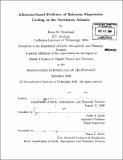Alkenone-based evidence of Holocene slopewater cooling in the northwest Atlantic
Author(s)
Kneeland, Jessie M. (Jessie Mary)
DownloadFull printable version (3.811Mb)
Other Contributors
Massachusetts Institute of Technology. Dept. of Earth, Atmospheric, and Planetary Sciences.
Advisor
Julian P. Sachs.
Terms of use
Metadata
Show full item recordAbstract
Alkenone-based estimates of sea surface temperature (SST) in the northwest Atlantic during the last 10,000 years are presented and used to assess scenarios for Holocene climate variability. Alkenone concentration and unsaturation records are presented from cores KNR140-39GGC, KNR140-51GGC, MD95-2028, MD95-2031, and MD95-2025 from the Blake Ridge (320N), Carolina Slope (330N), Fogo Seamount (42°N), Narwhal (440N), and Orphan Basin (500N) respectively. The southernmost core, from the Blake Ridge, indicates very little temperature variation over the Holocene. Somewhat inshore and to the north of that location, the Carolina Slope record shows a slight cooling trend of about 1.50C over the past 5,000 years, which is interrupted by a brief but sudden drop of about 1C between 3,000 and 2,000 years before present. Lack of age control for the core from Fogo Seamount prevents any conclusions about the time frame of alkenone variation at that location. At the Narwhal site, which is not far from the Laurentian fan, a strong and consistent cooling of 9C is the most recent pattern of variation. Alkenone concentrations from the Orphan Basin were not sufficient for reliable measurement of a Holocene temperature trend. (cont.) The general pattern of strong cooling in the northern slope water region and very modest cooling south of Cape Hatteras, where the Gulf Stream separates from the coastline and heads out. to sea, may suggest a shift in mean Gulf Stream path as a possible culprit for the temperature record seen at the Narwhal site. However, changes of incoming solar radiation or seasonality of alkenone production over the Holocene provide alternative mechanisms for alkenone temperature variation.
Description
Thesis (S.M.)--Massachusetts Institute of Technology, Dept. of Earth, Atmospheric, and Planetary Sciences, 2006. Includes bibliographical references (p. 85-89).
Date issued
2006Department
Massachusetts Institute of Technology. Department of Earth, Atmospheric, and Planetary SciencesPublisher
Massachusetts Institute of Technology
Keywords
Earth, Atmospheric, and Planetary Sciences.